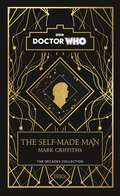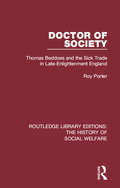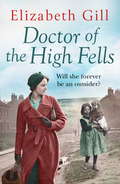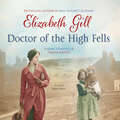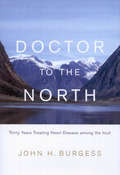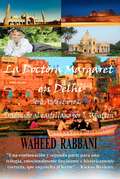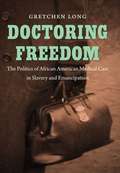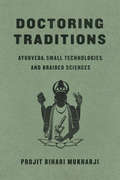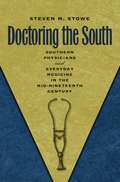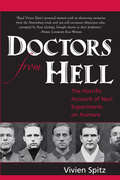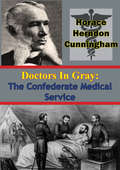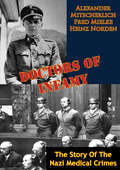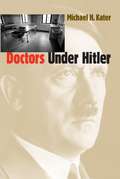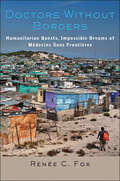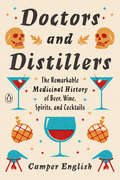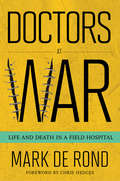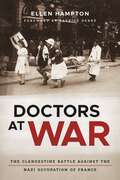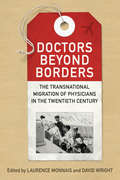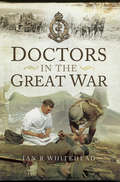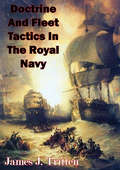- Table View
- List View
Doctor Who: a 1980s story
by Mark Griffiths Doctor Who*Part of the six books for six decades collection*Midnight, 1984.In a sprawling, run-down housing estate in south London, a man returning from a night out in the West End finds himself pursued by a strange hooded figure.So naturally when the Doctor and Romana arrive in the TARDIS the next day, they find themselves in the middle of a crime scene.But when child genius Matthew Pickles - inventor of a hugely popular handheld videogame - arrives to help them crack the case, they discover there is more to this than meets the eye.Someone has been messing with technology that's not of this earth, blurring the lines between human . . . and cyber. And it looks like they're out for revenge.In a world on the brink of gadgets and gismos and dangerous tech, the pair must uncover the killer, before they strike again.
Doctor Zhivago
by Boris PasternakIn one of the most powerful epics of all time, Pasternak tells the story of one man's youth, growth and maturity against the historic panorama of the Russian Revolution.
Doctor of Society: Tom Beddoes and the Sick Trade in Late-Enlightenment England (Routledge Library Editions: The History of Social Welfare #17)
by Roy PorterFirst published in 1992, this book explores how we come to hold our present attitudes towards health, sickness and the medical profession. Roy Porter argues that the outlook of the age of Enlightenment was crucially important in the creation of modern thinking about disease, doctors and society. To illustrate this viewpoint, he focuses on Thomas Beddoes, a prominent doctor of the eighteenth century and examines his challenging, pugnacious, radical and often amusing views on a wide range of issues concerning the place of illness and medicine in society. Many modern debates in medicine continue to echo the topics which Beddoes himself discussed in his ever-trenchant and provocative manner. This book will be of interest to those studying the history of medicine, social history and the Enlightenment.
Doctor of the High Fells: A Gritty Saga About One Woman's Determination to Make a Difference
by Elizabeth GillWill she forever be an outsider?The perfect fireside read for wintry nights, for fans of THE WINTER BABY by Sheila Newberry and THE MISTLETOE SELLER by Dilly Court.Determined to practise as a doctor, Prue escapes a loveless marriage to journey far from home and join a surgery in Tow Law. But she soon finds that long hours and limited resources are only the beginning - gaining the townspeople's trust will be her greatest challenge of all.Elizabeth Gill's next northern saga THE QUARRYMAN'S WIFE is available to preorder now! Just search 9781786482662 Praise for Elizabeth Gil's latest book, SNOW ANGELS, from real readers: 'This is a real love story with twists of family saga' Debra, Amazon reviewer 'Snow angels is a most enchanting book. It keeps you captivated in an exciting world with plenty of twists and turns' Sally, Amazon reviewer 'The story is full of fantastic descriptions of the North Country, where Elizabeth Gill herself has always lived, and which she clearly loves with all her heart.' Amazon reviewerAlso by Elizabeth Gill:Snow AngelsThe Guardian AngelNobody's ChildMiss Appleby's AcademyThe Singing WindsFar From My Father's HouseAnd available to pre-order now: The Quarryman's Wife
Doctor of the High Fells: A Gritty Saga About One Woman's Determination to Make a Difference
by Elizabeth GillFrom the bestselling author of Miss Appleby's Academy, comes a gritty saga perfect for fans of Dilly Court, Maggie Hope and Nadine Dorries.Prue's heart beat hard - she had heard of the low seams of the mines of northwest Durham and she had always had a fear of being enclosed. This was her job, she told herself, this was what she had wanted. She must do it. So she picked up her bag and followed them to the cage which carried the miners below ground, praying that the man did not die, that she need not produce some miracle . . . Determined to practise as a doctor, Prue escapes a loveless marriage to journey far from home and join a surgery in Tow Law. But she soon finds that long hours and limited resources are only the beginning - gaining the townspeople's trust will be her greatest challenge of all. From the bestselling author of Miss Appleby's Academy comes the story of Prue Stanhope, young woman doctor to the miners of Tow Law, County Durham.(P)2015 WF Howes Ltd
Doctor to the North
by John H. BurgessFor several weeks a year, over three decades, he worked as a consulting cardiologist in the Canadian North, a first-hand witness to rapidly changing disease patterns among the Inuit as a Western lifestyle became more prevalent. Through the stories of some of his Inuit patients, Burgess presents a broad spectrum of heart diseases and discusses how they can be prevented.
Doctor to the North: Thirty Years Treating Heart Disease among the Inuit (Footprints Series #7)
by John H. BurgessFor several weeks a year, over three decades, he worked as a consulting cardiologist in the Canadian North, a first-hand witness to rapidly changing disease patterns among the Inuit as a Western lifestyle became more prevalent. Through the stories of some of his Inuit patients, Burgess presents a broad spectrum of heart diseases and discusses how they can be prevented.
Doctora Margaret en Delhi
by J. Whitten Waheed RabbaniLa Doctora Margaret en Delhi es el Libro 2 de la Serie Azadi, y continuación del Libro 1, El Cofre de Mar de la Doctora Margaret. Esta novela de ficción histórica continúa el viaje de Margaret desde el tiempo cuando ella y su marido canadiense participaron en la guerra en Crimea en 1854. La Doctora Margaret viaja sola a la India para poder estar con sus padres en la Misión Presbiteriana Americana en Futteguhr, y de allí a su puesto en un hospital en Delhi. Allí no sólo tiene que sobreponerse a las presiones del trabajo, pero también enfrentarse a sus contrincantes, y a las intrigas de los Mughal en el Fuerte Rojo de Delhi. Los eventos que desencadenaron el Motín Indio/Rebelión, que estalla en 1857 afectaron profundamente no sólo a la vida de Margaret, pero también a las de los que la querían y las de otros que le deseaban mal. También involucrado en toda la conmoción de esta época está el Sepoy Sharif Khan Bhadur, el abuelo del Doctor Wallidad, médico americano. Esta serie cubre los eventos emocionantes y la conmoción que arrasaron a la India desde 1857 hasta 1947 y tuvieron como resultado la posterior independencia del país. Esas incidencias están descritas en los capítulos del relato de esa época, y luego los de las vidas de sus descendientes en los años 1960. "Una continuación y segunda parte para una trilogía, emocionalmente fascinante e históricamente correcta, que engancha al lector" - Kirkus Reviews
Doctoring Freedom
by Gretchen LongFor enslaved and newly freed African Americans, attaining freedom and citizenship without health for themselves and their families would have been an empty victory. Even before emancipation, African Americans recognized that control of their bodies was a critical battleground in their struggle for autonomy, and they devised strategies to retain at least some of that control. In Doctoring Freedom, Gretchen Long tells the stories of African Americans who fought for access to both medical care and medical education, showing the important relationship between medical practice and political identity. Working closely with antebellum medical journals, planters' diaries, agricultural publications, letters from wounded African American soldiers, WPA narratives, and military and Freedmen's Bureau reports, Long traces African Americans' political acts to secure medical care: their organizing mutual-aid societies, their petitions to the federal government, and, as a last resort, their founding of their own medical schools, hospitals, and professional organizations. She also illuminates work of the earliest generation of black physicians, whose adult lives spanned both slavery and freedom. For African Americans, Long argues, claiming rights as both patients and practitioners was a political and highly charged act in both slavery and emancipation.
Doctoring Traditions: Ayurveda, Small Technologies, and Braided Sciences
by Projit BihariLike many of the traditional medicines of South Asia, Ayurvedic practice transformed dramatically in the later nineteenth and early twentieth centuries. With Doctoring Tradition, Projit Bihari Mukharji offers a close look at that recasting, upending the widely held yet little-examined belief that it was the result of the introduction of Western anatomical knowledge and cadaveric dissection. Rather, Mukharji reveals, what instigated those changes were a number of small technologies that were introduced in the period by Ayurvedic physicians, men who were simultaneously Victorian gentlemen and members of a particular Bengali caste. The introduction of these devices, including thermometers, watches, and microscopes, Mukharji shows, ultimately led to a dramatic reimagining of the body. By the 1930s, there emerged a new Ayurvedic body that was marked as distinct from a biomedical body. Despite the protestations of difference, this new Ayurvedic body was largely compatible with it. The more irreconcilable elements of the old Ayurvedic body were then rendered therapeutically indefensible and impossible to imagine in practice. The new Ayurvedic medicine was the product not of an embrace of Western approaches, but of a creative attempt to develop a viable alternative to the Western tradition by braiding together elements drawn from internally diverse traditions of the West and the East.
Doctoring the South
by Steven M. StoweOffering a new perspective on medical progress in the nineteenth century, Steven M. Stowe provides an in-depth study of the midcentury culture of everyday medicine in the South. Reading deeply in the personal letters, daybooks, diaries, bedside notes, and published writings of doctors, Stowe illuminates an entire world of sickness and remedy, suffering and hope, and the deep ties between medicine and regional culture.In a distinct American region where climate, race and slavery, and assumptions about "southernness" profoundly shaped illness and healing in the lives of ordinary people, Stowe argues that southern doctors inhabited a world of skills, medicines, and ideas about sickness that allowed them to play moral, as well as practical, roles in their communities. Looking closely at medical education, bedside encounters, and medicine's larger social aims, he describes a "country orthodoxy" of local, social medical practice that highly valued the "art" of medicine. While not modern in the sense of laboratory science a century later, this country orthodoxy was in its own way modern, Stowe argues, providing a style of caregiving deeply rooted in individual experience, moral values, and a consciousness of place and time.
Doctors From Hell: The Horrific Account of Nazi Experiments on Humans
by Vivien SpitzA court reporter for the Nuremberg war crimes trial of Nazi doctors reveals the shocking truth of their torture and murder in this monumental memoir.Vivien Spitz reported on the Nuremberg trials for the U.S. War Department from 1946 to 1948. In Doctors from Hell, she vividly describes her experiences both in and out of the courtroom. A chilling story of human depravity and ultimate justice, this important memoir includes trial transcripts as well as photographs used as evidence.The author describes the experience of being in bombed-out, dangerous, post-war Nuremberg. She recounts dramatic courtroom testimony and the reactions of the defendants to the proceedings. Witnesses tell of experiments in which they were deprived of oxygen; frozen; injected with malaria, typhus, and jaundice; subjected to the amputation of healthy limbs; forced to drink seawater for weeks at a time; and other horrors.Doctors from Hell is a significant addition to the literature on World War II and the Holocaust, medical ethics, human rights, and the barbaric depths to which human beings can descend.“In this personal account of her service in the Nuremberg War Crimes Trials, Vivien Spitz continues to contribute to the cause of human rights.” —President James Carter
Doctors In Gray: The Confederate Medical Service
by Horace Herndon Cunningham"H. H. Cunningham's Doctors in Gray, first published more than thirty years ago, remains the definitive work on the medical history of the Confederate army. Drawing on a prodigious array of sources, Cunningham paints as complete a picture as possible of the daunting task facing those charged with caring for the war's wounded and sick.Of the estimated 600,000 Confederate troops, Cunningham claims the 200,000 died either from battle wounds of from illness--the majority, surprisingly, from illness. Despite these grim statistics, Confederate medical personnel frequently performed heroically under the most primitive of circumstances and made imaginative use of limited resources. Cunningham provides detailed information on the administration of the Confederate Medical Department, the establishment and organization of Confederate hospitals, the experiences of medical officers in the field, the manufacture and procurement of supplies, the causes and treatment of diseases, and the beginning of modern surgical practices." - Print ed.
Doctors Of Infamy: The Story Of The Nazi Medical Crimes
by Heinz Norden Alexander Mitscherlich Fred MielkeWith 16 pages of photographsOne of the most shocking aspects of the Nazi treatment of their prisoners was the wanton cruelty of the doctors assigned to the concentration camps that were dotted throughout occupied Europe. In an ironic perversion of their Hippocratic oath doctors, such as the infamous Mangele, carried out horrendous experiments on their captive victims in the name of science. As part of the Nuremberg trials the Nazi medical establishment was called to account for these crimes against humanity. Alexander Mitscherlich was the doctor assigned to carry out a full investigation into the crimes across all of Europe; in his report embodied in this book, reported on the awful scale and complicity of the Nazis. The terrible details have to be read to be believed in this shocking book.
Doctors Under Hitler
by Michael H. Kater"A brilliant attempt to explain the profound historical crisis into which medicine had plummeted during the Nazi period with the tried methods of social history.--Historische Zeitschrift"The author has drawn from an extraordinary range of sources, and the weight of evidence he compiles will certainly give pause to anyone who still wants to believe that professionals kept their hands clean in this era of great and methodical crimes.--Journal of Modern History"Kater's important book deserves close attention from historians of medicine and German historians alike.--IsisIn this history of medicine and the medical profession in the Third Reich, Michael Kater examines the career patterns, educational training, professional organization, and political socialization of German physicians under Hitler. His discussion ranges widely, from doctors who participated in Nazi atrocities, to those who actively resisted the regime's perversion of healing, to the vast majority whose ideology and behavior fell somewhere between the two extremes. He also takes a chilling look at the post-Hitler medical establishment's problematic relationship to the Nazi past. -->
Doctors Without Borders: Humanitarian Quests, Impossible Dreams of Médecins Sans Frontières
by Renée C. FoxAn intimate portrait of the renowned international humanitarian organization.Winner of the PROSE Award for Excellence, Sociology and Social Work of the Association of American PublishersThis study of Médecins Sans Frontières / Doctors Without Borders (MSF) casts new light on the organization’s founding principles, distinctive culture, and inner struggles to realize more fully its "without borders" transnational vision.Pioneering medical sociologist Renée C. Fox spent nearly twenty years conducting extensive ethnographic research within MSF, a private international medical humanitarian organization that was created in 1971 and awarded the Nobel Prize for Peace in 1999. With unprecedented access, Fox attended MSF meetings and observed doctors and other workers in the field. She interviewed MSF members and participants and analyzed the content of such documents as communications between MSF staff members within the offices of its various headquarters, communications between headquarters and the field, and transcripts of internal group discussions and meetings. Fox weaves these threads of information into a rich tapestry of the MSF experience that reveals the dual perspectives of an insider and an observer. The book begins with moving, detailed accounts from the blogs of women and men working for MSF in the field. From there, Fox chronicles the organization’s early history and development, paying special attention to its struggles during the first decades of its existence to clarify and implement its principles. The core of the book is centered on her observations in the field of MSF’s efforts to combat a rampant epidemic of HIV/AIDS in postapartheid South Africa and the organization’s response to two challenges in postsocialist Russia: an enormous surge in homelessness on the streets of Moscow and a massive epidemic of tuberculosis in the penal colonies of Siberia. Fox’s accounts of these crises exemplify MSF’s struggles to provide for thousands of people in need when both the populations and the aid workers are in danger.Enriched by vivid photographs of MSF operations and by ironic, self-critical cartoons drawn by a member of the Communications Department of MSF France, Doctors Without Borders highlights the bold mission of the renowned international humanitarian organization even as it demonstrates the intrinsic dilemmas of humanitarian action.
Doctors and Distillers: The Remarkable Medicinal History of Beer, Wine, Spirits, and Cocktails
by Camper English&“At last, a definitive guide to the medicinal origins of every bottle behind the bar! This is the cocktail book of the year, if not the decade.&” —Amy Stewart, author of The Drunken Botanist and Wicked Plants&“A fascinating book that makes a brilliant historical case for what I&’ve been saying all along: alcohol is good for you…okay maybe it&’s not technically good for you, but [English] shows that through most of human history, it&’s sure beat the heck out of water.&” —Alton Brown, creator of Good EatsBeer-based wound care, deworming with wine, whiskey for snakebites, and medicinal mixers to defeat malaria, scurvy, and plague: how today's tipples were the tonics of old.Alcohol and Medicine have an inextricably intertwined history, with innovations in each altering the path of the other. The story stretches back to ancient times, when beer and wine were used to provide nutrition and hydration, and were employed as solvents for healing botanicals. Over time, alchemists distilled elixirs designed to cure all diseases, monastic apothecaries developed mystical botanical liqueurs, traveling physicians concocted dubious intoxicating nostrums, and the drinks we&’re familiar with today began to take form. In turn, scientists studied fermentation and formed the germ theory of disease, and developed an understanding of elemental gases and anesthetics. Modern cocktails like the Old-Fashioned, Gimlet, and Gin and Tonic were born as delicious remedies for diseases and discomforts. In Doctors and Distillers, cocktails and spirits expert Camper English reveals how and why the contents of our medicine and liquor cabinets were, until surprisingly recently, one and the same.
Doctors at War: Life and Death in a Field Hospital (The Culture and Politics of Health Care Work)
by Mark de RondDoctors at War is a candid account of a trauma surgical team based, for a tour of duty, at a field hospital in Helmand, Afghanistan. Mark de Rond tells of the highs and lows of surgical life in hard-hitting detail, bringing to life a morally ambiguous world in which good people face impossible choices and in which routines designed to normalize experience have the unintended effect of highlighting war’s absurdity. With stories that are at once comical and tragic, de Rond captures the surreal experience of being a doctor at war. He lifts the cover on a world rarely ever seen, let alone written about, and provides a poignant counterpoint to the archetypical, adrenaline-packed, macho tale of what it is like to go to war. Here the crude and visceral coexist with the tender and affectionate. The author tells of well-meaning soldiers at hospital reception, there to deliver a pair of legs in the belief that these can be reattached to their comrade, now in mid-surgery; of midsummer Christmas parties and pancake breakfasts and late-night sauna sessions; of interpersonal rivalries and banter; of caring too little or too much; of tenderness and compassion fatigue; of hell and redemption; of heroism and of playing God. While many good firsthand accounts of war by frontline soldiers exist, this is one of the first books ever to bring to life the experience of the surgical teams tasked with mending what war destroys.
Doctors at War: The Clandestine Battle against the Nazi Occupation of France
by Ellen HamptonDoctors at War tells the stories of physicians in France working to impede the German war effort and undermine French collaborators during the Occupation from 1940 to 1945. Determined to defeat the Third Reich’s incursion, one group of prominent Paris doctors founded a medical network to treat injured Resistance fighters who they then secretly transported to Allied countries to avoid forced labor in Germany. Another team of medics organized a cabal focused on intelligence gathering and sabotage that became one of the largest in wartime France, even after the Gestapo arrested and imprisoned its leaders. Deported to concentration camps, these physicians continued to frustrate Nazi efforts by rendering aid and keeping their fellow prisoners alive. Others joined rural guerrilla camps to care for the young conscripts fighting to block German reinforcements from reaching Normandy after the D-Day landing.These stories, assembled here for the first time, add a crucial dimension to the history of Occupied France. Written for both historians and general readers of World War II history, Doctors at War stands as a dramatic, character-driven account of physicians’ courage and resilience in the face of evil. It serves as a window into life under a fascist regime and the travails of doctors who negotiated the terrifying moral labyrinth that was the German military’s occupation of France.
Doctors beyond Borders: The Transnational Migration of Physicians in the Twentieth Century
by David Wright Laurence MonnaisThe transnational migration of health care practitioners has become a critical issue in global health policy and ethics. Doctors beyond Borders provides an essential historical perspective on this international issue, showing how foreign-trained doctors have challenged - and transformed - health policy and medical practice in countries around the world.Drawing on a wide variety of sources, from immigration records and medical directories to oral histories, the contributors study topics ranging from the influence of South Asian doctors on geriatric medicine in the United Kingdom to the Swedish reaction to the arrival of Jewish physicians fleeing Nazi Germany and the impact of the Vietnam War on the migration of doctors to Canada. Combining social history, the history of health and medicine, and immigration history, Doctors beyond Borders is an impressive selection of essays on a topic that continues to have global relevance.
Doctors in the Great War
by Ian R. WhiteheadDoctors played a bigger role in the First World War than in any other previous conflict. This reflected not only the War's unprecedented scale but a growing recognition of the need for proper medical cover. The RAMC had to be expanded to meet the needs of Britain's citizen army. As a result by 1918 some 13,000 doctors were on active service over half the nation's doctors.Strangely, historians have largely neglected the work of doctors during the War. Doctors in the Great War brings to light the thoughts and motivations of doctors who served in 1914-1918, by drawing on a wealth of personal experience documentation, as well as official military sources and the medical press. The author examines the impact of the War upon the medical profession and the Army. He looks at the contribution of medical students, and the extent to which new professional opportunities became available to women doctors.An insight into the breadth of responsibilities undertaken by Medical Officers is given through analysis of the work of various medical units on the Western Front, demonstrating the important role played by doctors in the maintenance of the Army's physical and mental well-being. The differences between civilian and military medicine are discussed with a consideration of the arrangements for the training of doctors, and an assessment of the difficulties faced by doctors in adapting to military priorities and dealing with new challenges such as gas poisoning, infected wounds and shell shock.Doctors in the Great War will undoubtedly appeal to general readers, students and specialists in the history of war and society, as well as to those with an interest in the medical profession.As featured in the Derby Telegraph, Dover Express and Kent & Sussex Courier
Doctors of Empire
by Hoi-Eun KimThe history of German medicine has undergone intense scrutiny because of its indelible connection to Nazi crimes. What is less well known is that Meiji Japan adopted German medicine as its official model in 1869. In Doctors of Empire, Hoi-eun Kim recounts the story of the almost 1,200 Japanese medical students who rushed to German universities to learn cutting-edge knowledge from the world leaders in medicine, and of the dozen German physicians who were invited to Japan to transform the country's medical institutions and education.Shifting fluently between German, English, and Japanese sources, Kim's book uses the colourful lives of these men to examine the impact of German medicine in Japan from its arrival to the pinnacle of its influence and its abrupt but temporary collapse at the outbreak of the First World War.Transnational history at its finest, Doctors of Empire not only illuminates the German origins of modern medical science in Japan but also reinterprets the nature of German imperialism in East Asia.
Doctors of Infamy: The Story of the Nazi Medical Crimes
by Heinz Norden Alexander Mitscherlich Fred MielkeThis book documents the German medical war crimes. In 1946, twenty-three German defendants were indicted and arraigned before a war crimes tribunal widely known as the "Nuremberg Medical Trial." Twenty of the defendants were physicians who, as governmental, military, or SS officials, stood at or near the top of the medical hierarchy of the Third Reich. The book includes statements by the leading figures of German medicine in the trials, a discussion of medical ethics and a pictorial section.
Doctors, Bureaucrats, and Public Health in France: 1888-1902 (Routledge Library Editions: History of Medicine #6)
by Martha L. HildrethOriginally published in 1987 Doctors, Bureaucrats and Public Health in France focuses on crucial period of 1888-1902, arguably considered the creation of the modern medical system in France. Scientific developments, demographic and political concerns sparked unprecedented period of government action concerning medical care. The nature of the resulting legislation was largely determined by a new medical union movement, promoting the professional goals of private physicians. The book focuses on the formation of the physicians Union movement and its role within medical legislation, as well as its effect on other public health programs. It also focuses on the interplay of professional concerns and political issues which together describe the medical politics of the era.
Doctrine And Fleet Tactics In The Royal Navy
by James J. TrittenThe U.S. Navy was characterized by a recent RAND study as being "the supra-national institution that has inherited the British Navy's throne to naval supremacy." Given the legacy of the traditions that have passed from the Royal Navy to the U.S. Navy, one cannot consider naval doctrine in the U.S. Navy without first conducting an analysis of how navy doctrine evolved in Great Britain. This paper reviews and analyzes doctrine in the British Navy. It concludes with an assessment of the doctrinal process in the Royal Navy and with potential lessons for us today.
